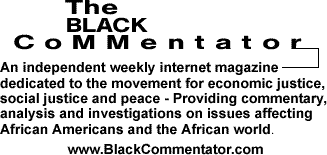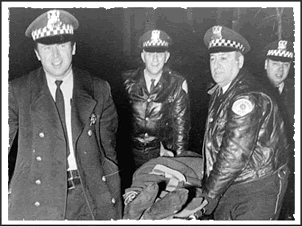
Book Review:
The Black Panthers and the Assassination of Fred Hampton
By Hans Bennett
BlackCommentator.com Guest Commentator
The Assassination of Fred Hampton: How the FBI and the Chicago Police Murdered a Black Panther, by Jeffrey Haas, published by Lawrence Hill Books (November, 2009).
On the morning of December 4, 1969, lawyer Jeffrey
Haas received a call from his partner at the People’s Law Office, informing
him that early that morning
Haas went straight to the police station to speak
with
Jeffrey Haas’ account of this conversation with
Johnson jumps right out from the inside cover of his new book titled,
The
Assassination of Fred Hampton: How the FBI and the Chicago Police Murdered
a Black Panther, just released today. In this excellent new book,
Haas gives his personal account of defending the Panther survivors of
the Dec. 4 police assault against the criminal charges that were later
dropped, and of filing a civil rights lawsuit, Hampton v. Hanrahan,
on behalf of the survivors and the families of Mark Clark and Fred Hampton.
The civil rights lawsuit lasted for almost 13 years, but ended with a
$1.85 million settlement paid equally by the city, county, and federal
governments. This battle in the courtroom is a long and complex story,
but the 375-page book packs a punch and clearly presents the legal complexities
without watering down Haas’ outrage about
The Assassination of Fred Hampton
An autopsy conducted on
At 4am on Dec. 4,
A county grand jury indicted each of the seven Panther
survivors for attempted murder, armed violence, and other weapons charges,
but all these charges would later be dropped. Hanrahan
and police were first exonerated from any misconduct by the police Internal
Investigations Division. Next, a coroner’s inquest found Hampton and Clark’s
deaths were “justifiable homicide.” A federal grand jury, led by deputy
attorney general Jerris Leonard investigated whether Hanrahan
and police had violated the civil rights of the Panthers inside
After the federal grand jury’s ruling in May 1970 that exonerated Hanrahan and others, they decided to file the civil rights lawsuit. At the meeting where the lawyers, Dec. 4 survivors, and family members of Hampton and Clark made their decision, Clark’s mother Fannie expressed how they all were feeling, saying “We can’t just do nothing. Mark and Fred should still be alive. I want to bring their killers to trial.” Reflecting back, Haas explains why the lawsuit was an important legal strategy as well. “In civil cases, extensive discovery is allowed. We could get to cross-examine all the defendants under oath at depositions, with court reporters recording what they said. The contradictions between Hanrahan’s and the raiders’ account, and the physical evidence made the prospect of confronting the defendants a trial lawyer’s dream…we needed to write the complaint to combine the claims of the survivors and the deceased into one lawsuit against all the perpetrators…The legal construct we had found was to charge all the actors in a conspiracy to act together. That way we combined Hanrahan, [Hanrahan’s assistant, Richard] Jalovec, the fourteen raiders, the crime lab people, and those who falsified the investigation…In May of 1970 we filed our complaint. We had no idea we were embarking on a 13-year battle,” writes Haas.
The joint-civil suit was assigned to a right-wing judge named Joseph Sam Parry, who threw out their entire complaint on February 3, 1972. They appealed to the Seventh Circuit Court and on August 4, 1973, the Court overturned Parry, and sent it back for a new trial. Unfortunately, they were unable to get a new judge, and throughout the subsequent 18-month trial, Parry was extremely biased and blocked all kinds of testimony and evidence from being entered into the record. The jury was deadlocked, but instead of declaring a mistrial, Parry himself ruled to dismiss the case entirely. Haas and PLO’s subsequent appeal of Parry’s ruling to the Seventh Circuit was successful, and the case was sent back down to the district court for a new trial. Fortunately, this time they got a new judge, who urged the defendants to make a settlement before starting a new trial. Finally, on February 28, 1983, the settlement was made, and Hampton et al. received $1.85 million from the city, county, and federal governments.

COINTELPRO and Fred Hampton
The FBI’s top-secret and illegal counterintelligence
program dubbed “COINTELPRO” became public after a 1971 break-in to the
FBI office in
This same document stated: “Through counterintelligence it should be possible to pinpoint potential troublemakers and neutralize them.” Another stated goal was “to prevent the long-range growth of militant black nationalist organizations, especially among youth. Specific tactics to prevent these groups from converting young people must be developed.” One specific tactical approach was expressed in an April 3, 1968 communique arguing that “The Negro youth and moderates must be made to understand that if they succumb to revolutionary teaching, they will be dead revolutionaries.”
In terms of scale, the FBI’s war of repression against
the Black liberation movement of the 1960s and 1970s was greatest against
the Panthers. In addressing why the Panthers were targeted so intensely
by COINTELPRO, Noam Chomsky wrote in 1973: “A
top secret Special Report for the president in June 1970 gives some insight
into the motivations for the actions undertaken by the government to destroy
the Black Panther Party. The report describes the party as ‘the most active
and dangerous black extremist group in the
When these liberated COINTELPRO files became public,
Haas, PLO, and his Panther clients immediately suspected that the Dec.
4 police raid had been part of this program, and that the FBI had viewed
One document showed a drawing made by the FBI’s
paid informant, William O’Neal, which provided the floor plan of
Another document surfaced showing that the FBI had made a deal with deputy attorney general Jerris Leonard, who led the 1970 federal grand jury investigation. In an effort to conceal the FBI’s role and the still-secret COINTELPRO, they decided that the criminal charges would be dropped against the seven Panther survivors, and in exchange the federal grand jury would rule in favor of Hanrahan and the police raiders.
A third explosive document showed a fake letter
sent to Jeff Fort, the leader of the Blackstone Rangers, which accused
the Panthers of planning a “hit” on Fort. The FBI hoped that the fake
letter would incite Fort and the Rangers to “take retaliatory action”
against
As this new documentation emerged, the FBI was added to the list of defendants for the civil rights lawsuit, and making the FBI pay 1/3 of the $1.85 million was a key part of the settlement.
Defending the
Haas was fresh out of law school when he first met Fred Hampton and was asked to work as a lawyer for the many Panther defendants that were victims of repression. Haas and several other young radical lawyers collectively opened the People’s Law Office (PLO) in Chicago and began defending Panthers, as well as Puerto Rican political prisoners, antiwar protesters, prisoner activists, and other revolutionary groups like Students for a Democratic Society, the Young Lords, and the Young Patriots. Alongside Haas’ account of working specifically on the Hampton case, he also reflects on many of the other struggles from that era that he became involved with, illustrating how Hampton’s assassination did not happen in a vacuum.
For example, on November 12, 1970, there was a shootout
between police and Panthers in the southern
The six Panther defendants were each charged with seven counts of attempted murder and became known as the “Carbondale Six.” Haas and the PLO defended them by arguing first that it was impossible to identify who in the house was actually shooting, and second that since the police began shooting at them first, unannounced, in the middle of the night, the Panthers acted in legitimate self-defense by shooting back. In a stunning victory, an all-white jury found the defendants innocent of all charges.
Haas writes that during the Carbondale Six trial,
he and two other PLO lawyers drove to
Haas writes that “
On September 13, Governor Nelson Rockefeller ordered
the state police to go in with their guns firing, and ultimately twenty-nine
prisoners and ten hostages were shot dead, with many more wounded. When
the National Lawyers Guild put out a call for lawyers to visit
The horror continued after the state police and prison authorities regained control. With tears in his eyes, Smith recounted how “the guards stripped us naked after the shooting. Then they made us crawl naked in the mud through a gauntlet where they beat us…They took me out of the line. They made me lie on a table naked on my back and put a football under my chin. They put their burning cigarettes out on me. Some dropped them from the catwalk above and were laughing. They told me if I moved and the football hit the ground I was dead. I tried not to move. I was sure they were going to kill me. They knew I was in charge of security and used me as an example to scare everyone else, because nobody else got this treatment.”
The accounts of other prisoners interviewed by Haas,
PLO, and other lawyers reinforced Smith’s heart-wrenching story. After
returning to
They Got Away With Murder
Certainly, the $1.85 million lawsuit was only a
partial victory. No amount of money can replace the lives of Hampton and
Clark, or heal the gunshot injuries that several of the Panther survivors
still suffer from today. Furthermore, it is painful to accept that none
of the conspirators were ever convicted of any criminal charges, nor were
they forced to pay for the settlement out of their own pockets. However,
the scale of victory should not be judged by the settlement money alone.
On the last page of the book, Haas describes a 2008 visit with Iberia
Hampton shortly after her husband Francis had passed away. He asked her
“after all these years, what do you think our lawsuit proved?” Without
hesitation
Indeed, they did get away with murder. In this context, the victorious civil rights lawsuit has been used to further expose and document this stark injustice. Many COINTELPRO files were made public because of the lawsuit, and the numerous conspirators were put under some scrutiny for the public to see. Today, if we learn anything from this story, it’s that we should have no illusions about how far the government is willing to go in repressing dissent and then covering it up. Also, the courtroom victory that was fought against all odds should inspire activists today who are working around issues of state repression and political prisoners. We can win, and we should never give up the fight.
[This article was originally published at www.TowardFreedom.com]
BlackCommentator.com Guest Commentator, Hans Bennett is an independent multi-media journalist (www.insubordination.blogspot.com) and co-founder of Journalists for Mumia Abu-Jamal (www.abu-jamal-news.com) He has written for numerous publications, including Alternet, ColorLines, Upside Down World, Z Magazine, Dissident Voice, and Toward Freedom Click here to contact Mr. Bennett.


